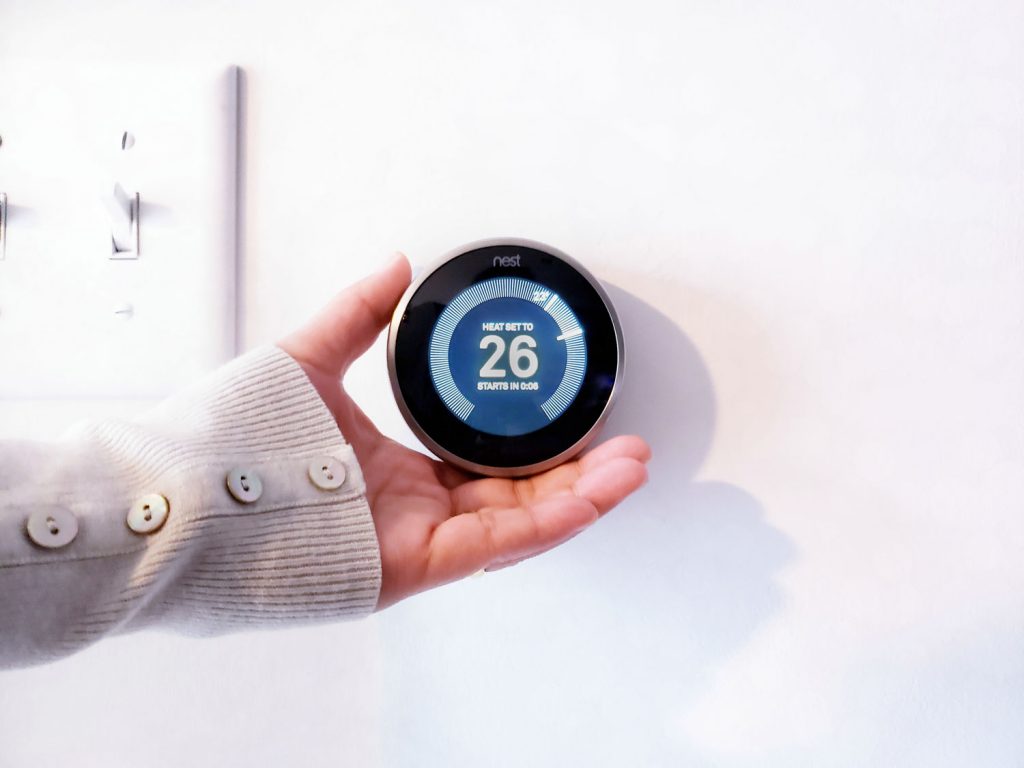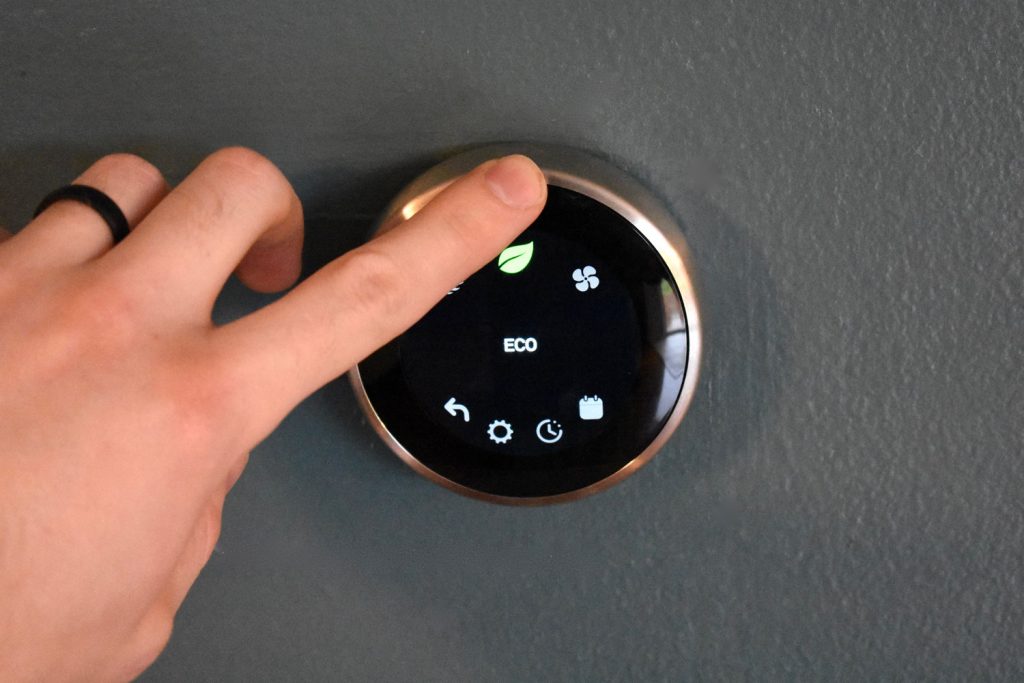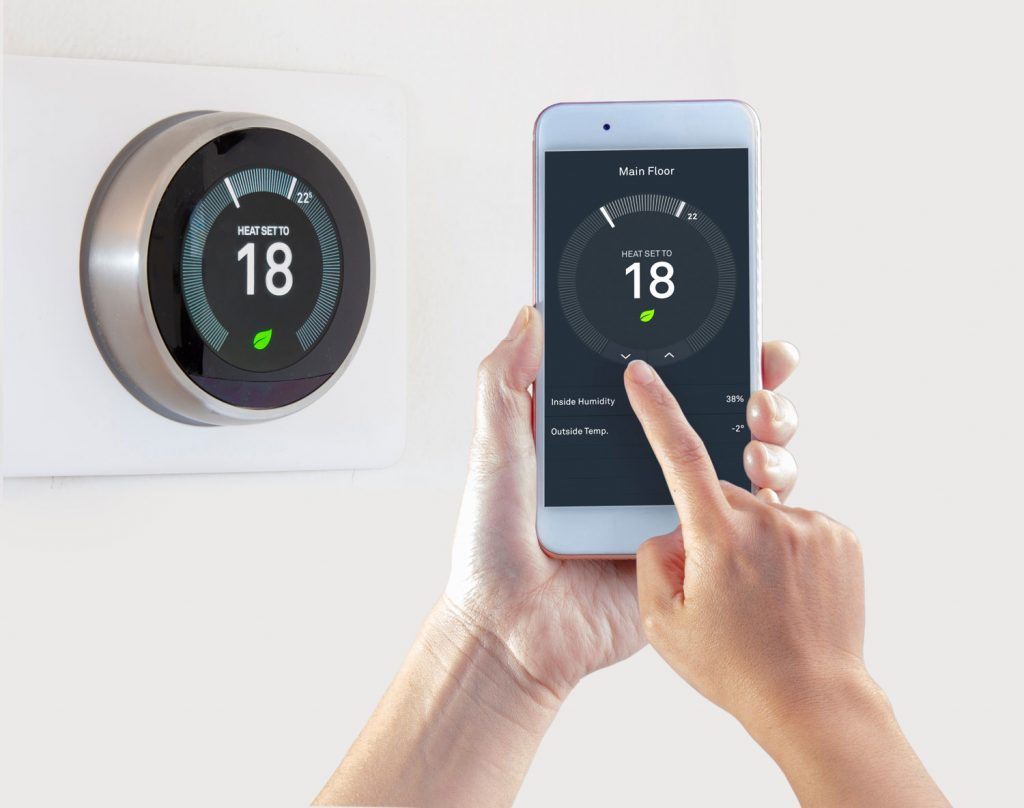Have you recently upgraded your old thermostat to a Nest Thermostat, and now you’re wondering if it can control the humidity inside your home? Wonder no more, for we have researched this question, and we’re here to bring you the best answer.
The short answer is, yes, the Nest can control humidity, albeit it does so indirectly. For systems with a built-in dehumidifier mode, utilize the 'Cool and Dry' setting on the Nest. The 'Cool and Dry' setting will automatically sense high humidity to enable the AC to cycle as needed on systems without a built-in dehumidifier mode.
We will talk about the specifics of how the Nest Thermostat controls the humidity in your home based on your heating and cooling configuration. There is also a section that is dedicated to helping you decide whether the Nest Thermostat is worth it or not. Read on!
![Using smart thermostat to change tempreture stock, Does Nest Thermostat Control Humidity [And How]?](https://hvacseer.com/wp-content/uploads/2022/02/Does-Nest-Thermostat-Control-Humidity-And-How--683x1024.png)
What is the Nest Thermostat?

Let’s briefly talk about the Nest Thermostat then we’ll jump right into the details of its humidity-controlling feature.
The Nest Thermostat is a smart thermostat that was designed by Tony Fadell. It is programmable, self-learning, and Wi-Fi enabled. It uses a Linux-based operating system.
How does Nest Thermostat control humidity?
The Nest Thermostat has three different ways of controlling the humidity based on the system that you have. It adapts to the system you have to maintain an ideal humidity.
Systems with a built-in dehumidifier mode
Air conditioners normally have a dehumidifier function to help cool the air by making the air dryer. Moisture in the air retains heat. The less moisture in the air, the less ambient heat is present in the room.
Most modern air conditioners improved this built-in function and included a dehumidification mode that gives users more control over the amount of moisture in the air.
Cool and Dry
According to Google Support, the Nest Thermostat has a feature called 'Cool and Dry.' This feature takes advantage of the built-in dehumidifier mode in air conditioners and central HVACs to reduce humidity.
Reduced humidity helps control the growth of mold in your home. Thus, dehumidifying helps create a healthier environment inside your home.
The Cool and Dry feature is automatically enabled when your Nest Thermostat is connected to an air conditioner or a central HVAC system that has a dehumidifier mode.
Systems without a built-in dehumidifier mode
What if your air conditioner or central HVAC system doesn’t have a dehumidifier mode? How will the Nest Thermostat control the humidity on these systems?
Cool and Dry can still control the humidity in your home even if your air conditioner or central HVAC system doesn’t have a dehumidifier mode. The Cool and Dry system takes advantage of your air conditioner’s natural ability to turn hot and humid air into cool and dry air to control the humidity inside your home.
The Nest Thermostat can sense very high humidity. It will automatically turn on the air conditioner to control the humidity—cycling the air conditioner on and off as needed.
When Cool and Dry is enabled, the Nest Thermostat might cool your home to a temperature that is lower than your target temperature. It can be 3 degrees Fahrenheit lower than the set temperature or up to 5 degrees Fahrenheit lower than your Eco Temperature.
Take note, however, that using Cool and Dry on a system with a dehumidifier mode can cause your electricity consumption to be higher than without it. This is because your air conditioner or central HVAC system will run more often than normal. Thus, it is best to enable the Cool and Dry feature only if you live in an extremely humid climate.
Fortunately, the Cool and Dry feature is disabled by default if the Nest Thermostat is connected to an air conditioner or central HVAC system that doesn’t have a dehumidifier mode.
Homes with a standalone humidifier
The Nest Thermostat will display if Cool and Dry is running. However, you will never see the Cool and Dry feature running if your home has a standalone humidifier that is connected to your Nest Thermostat.
The Nest Thermostat will not use its Cool and Dry feature if it is connected to a standalone dehumidifier. Instead, it will take advantage of your standalone dehumidifier to control the humidity in your home.
We have an interesting article about whether a special thermostat is a must with 2-stage furnaces.
More About The Nest 'Cool and Dry' Feature

In addition to seeing your Nest Thermostat display showing if Cool and Dry is running, you will also see it on your Nest app or Google Home app.
Cool and Dry will automatically turn on the air conditioner if the humidity levels go up while the air conditioner is not running. It will give your air conditioner regular intervals of rest while maintaining humidity levels. This is to prevent your air conditioner's coils from forming ice deposits.
You cannot set specific humidity values on your Nest Thermostat. This is because the Nest Thermostat relies on the abilities of connected appliances to manage the humidity inside your home. Because of this, there is a possibility that the Nest Thermostat might not be able to achieve a target humidity if homeowners can set specific humidity targets.
Instead of using exact values, the Nest Thermostat makes use of three water drops to set the approximate target humidity in four different levels. If none of the water drops are lit, the Nest Thermostat has no control of the humidity.
One lit water drop represents a low approximate humidity target. This could cause your air conditioner or centralized HVAC system to run more often to maintain a low humidity level.
Three water drops will be lit if you select a high approximate humidity target. This will reduce the number of times that your system will need to run to maintain the humidity level inside your home.
Check out Google Nest Learning Thermostat—with everything we've talked about it so far. Check it out on Amazon.
Is the Nest Thermostat Worth It?

The Nest Thermostat is pricier than most other thermostats, and some homeowners are wondering if it is really worth its price.
The Nest Thermostat is a smart programmable thermostat, allowing you to take control of your thermostat even when you’re not at home. It can connect to your home Wi-Fi system and connect to your phone through the Nest app or the Google Home app to give you access.
You can even control it through voice in case you’re in the middle of an exciting football game and don’t want to get up just to adjust the thermostat.
You can program it to change the temperature at specific times of the day. It can even track inside the house and make automatic adjustments based on what it learned from your previous preferences.
Yes, it can learn from your usage patterns during the first few weeks. It will then build automated parameters that will run whenever it meets specific conditions based on what it learned.
The longer you use the Nest Thermostat, the more it learns from your usage patterns. It will then create automation to match your preferences without you having to program anything on it.
This is what makes it a smart thermostat. And it works in concert with all other Google Nest products like smoke detectors, locks, doorbells, security cameras, and even speakers.

Advantages
It can save you money on your energy bill because it can turn on your heater and air conditioner at very accurate times of the day and only when you need them.
According to Google, the Nest Thermostat saves US customers 10-12% on their heating bills and up to 15% on their cooling bills. This is equivalent to an average of $131 to $145 worth of savings in a year. The Nest Thermostat can pay for itself in savings in just two years.
The Nest Thermostat has a feature that will automatically determine the settings that will give you the most savings. It is an "Energy Star Rated" appliance that has saved more than 82,512,000,000 kWh of energy since it was first released in 2011. This is not only good for your budget but also for the environment.
It also monitors your air conditioner, heater, or centralized HVAC system for possible issues. It will let you know, for example, if your air conditioner took longer than normal to get your house to a usual temperature.
Disadvantages
It is more expensive than a thermostat that is not smart. The price gets multiplied if you have a separate heating and cooling system for different floors in your house.
Another disadvantage is that installing the Nest Thermostat is not as simple as with non-smart thermostats. You might need professional help to get it installed in your home and get your heating and cooling (and even humidifier) systems properly connected to it.
The Google Nest Thermostat—a cheaper alternative that doesn’t have the ability to learn: check it out on Amazon.
Conclusion

The Nest Thermostat is a smart thermostat that can control the humidity inside your home. This can help to create a healthier environment for your home.
Read about whether a special thermostat is necessary with a gas fireplace.


